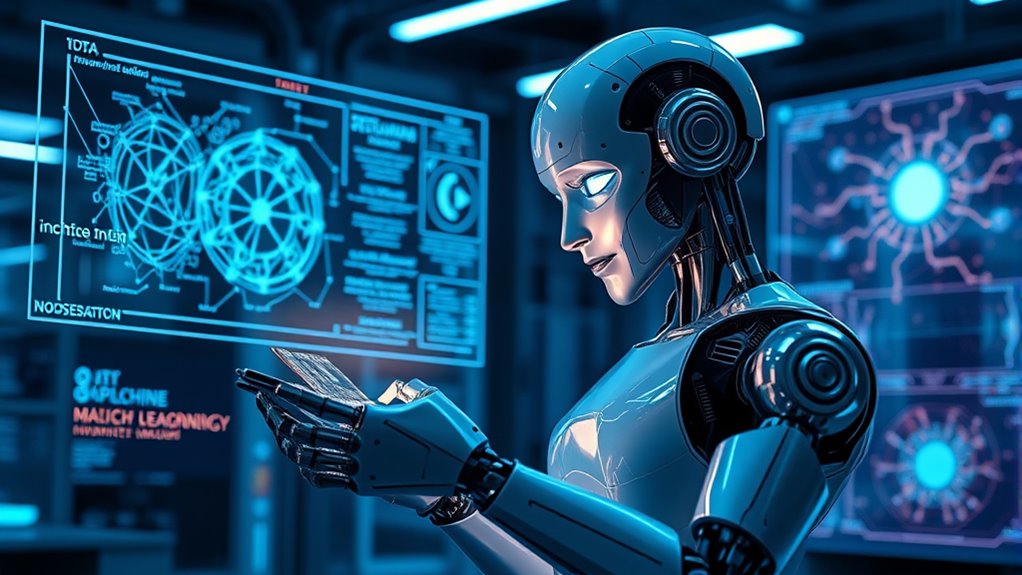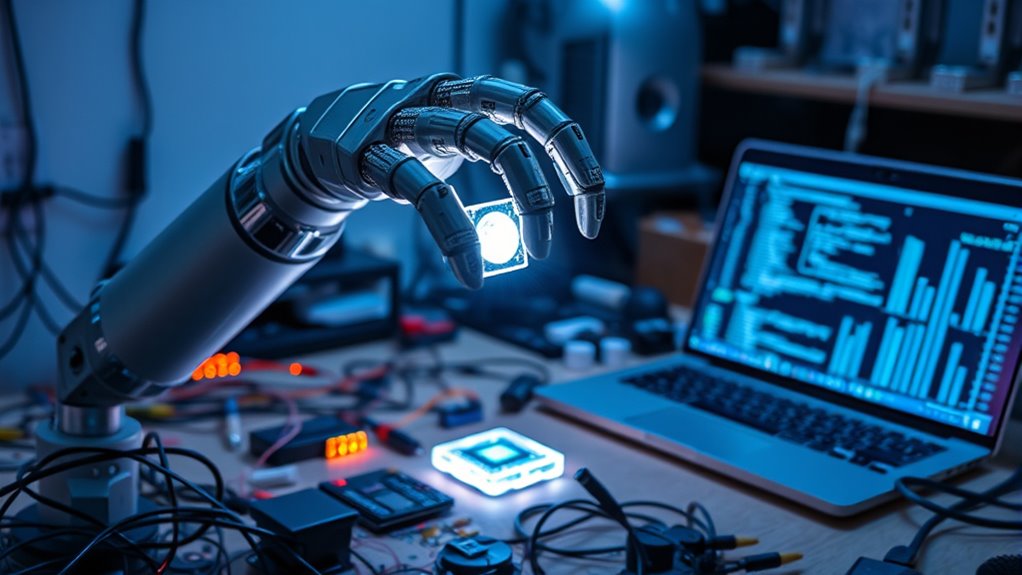Robotics uses machine learning to help robots understand and navigate their environment autonomously. They interpret sensor data from cameras, lidar, and ultrasonic sensors to make real-time decisions. With continuous learning, robots adapt to new situations, improving their skills over time. Adaptive control allows them to modify behaviors dynamically, like adjusting grip strength or balancing. If you keep exploring, you’ll discover how these advancements are shaping smarter, more reliable robots in various applications.
Key Takeaways
- Robots interpret sensor data with machine learning algorithms for environment understanding and obstacle detection.
- Machine learning enables autonomous robots to adapt to new environments and unexpected situations in real-time.
- Continuous learning processes help robots improve navigation, manipulation, and decision-making capabilities over time.
- Adaptive control systems use machine learning to modify behaviors dynamically based on performance feedback.
- Practical applications include robotic arms adjusting grip strength and autonomous vehicles refining route planning.

Have you ever wondered how robots are becoming smarter and more adaptable? The secret lies in how they leverage machine learning to improve their capabilities. One of the key areas where this is evident is autonomous navigation. Unlike traditional robots that follow fixed instructions, machines equipped with machine learning algorithms can interpret their environment, make decisions in real-time, and navigate complex spaces without human intervention. This ability hinges on the robot’s capacity to process vast amounts of sensor data—such as cameras, lidar, and ultrasonic sensors—and learn from it. Over time, the robot refines its understanding of obstacles, pathways, and dynamic changes in its surroundings. This continuous learning process allows the robot to adapt to new environments and unexpected situations, making autonomous navigation more reliable and efficient. Sensor data processing is a critical component in enabling these capabilities, as it allows robots to handle diverse and unpredictable scenarios effectively.
Adaptive control is another essential aspect where machine learning profoundly impacts robotics. Conventional control systems operate based on pre-programmed parameters, which can limit their flexibility. However, with adaptive control powered by machine learning, robots can modify their behavior on the fly. They analyze their performance data, identify patterns, and adjust control strategies dynamically to optimize tasks like grasping objects, balancing, or moving through unpredictable terrain. For example, a robotic arm learning to handle fragile objects can fine-tune its grip strength based on feedback, reducing damage and increasing success rates. This adaptability not only enhances performance but also reduces the need for constant reprogramming, allowing robots to function effectively in diverse and changing conditions.
Frequently Asked Questions
How Do Robots Learn From New Environments?
When you want robots to learn from new environments, you enable sensor integration so they can collect real-time data. Then, through reinforcement learning, they adapt their actions based on feedback, improving performance over time. This process allows robots to understand unfamiliar surroundings better, make smarter decisions, and refine their behavior continuously. By combining sensors and reinforcement learning, you empower robots to become more autonomous and effective in diverse, changing environments.
What Types of Machine Learning Algorithms Are Most Common in Robotics?
Think of machine learning algorithms as the secret sauce in robotics. You’ll find decision trees and neural networks among the most common algorithm types. Decision trees are like flowcharts that help robots make decisions quickly, while neural networks mimic the human brain to recognize patterns. These algorithms empower robots to adapt, learn, and perform tasks efficiently, making them smarter and more capable in diverse environments.
How Is Data Collected for Training Robotic Systems?
You collect data for training robotic systems mainly through sensor data, which includes inputs from cameras, LIDAR, and touch sensors. Additionally, you use simulation environments to generate vast amounts of data safely and efficiently. These methods help you teach robots to recognize objects, navigate environments, and perform tasks, ensuring they learn effectively from diverse and exhaustive datasets before applying their skills in real-world scenarios.
Can Robots Adapt in Real-Time Using Machine Learning?
Real-time robot adaptation really ramps up with machine learning, allowing robots to respond swiftly to sensor signals and sensor integration. You see, as robots gather new data, they analyze and adjust their motion and actions on the fly, fostering flexibility and finesse. This continuous learning process helps robots navigate unpredictable environments, improve performance, and perfect their precision, making them smarter, more responsive, and ready to tackle complex tasks instantly.
What Are the Limitations of Using Machine Learning in Robotics?
You should consider that machine learning in robotics faces limitations like sensor fusion challenges, where combining data from multiple sensors can be complex and error-prone. Additionally, ethical considerations come into play, especially regarding decision-making autonomy and data privacy. These issues can hinder performance and acceptance. While machine learning enhances robotics, you need to address these constraints to guarantee safety, reliability, and ethical use in real-world applications.
Conclusion
By now, you’ve seen how robotics leverages machine learning to improve efficiency and adaptability. With these advancements, aren’t we just edging closer to a future where robots seamlessly integrate into our daily lives? As you consider this, think about the potential and responsibility that come with such innovation. Will we harness this technology wisely, or let it shape a future beyond our control? The choice is in our hands—what kind of future do you want to create?









